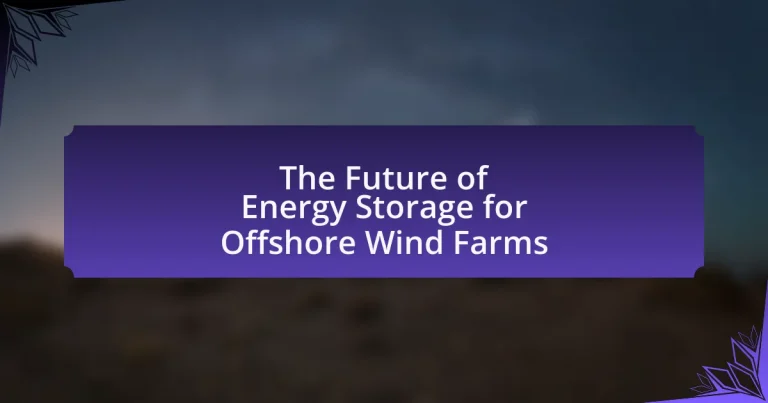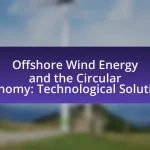The article focuses on the future of energy storage for offshore wind farms, highlighting the significance of advanced battery technologies, such as lithium-ion and solid-state batteries, as well as innovative solutions like pumped hydro storage and hydrogen production. It discusses how these technologies enhance the integration of offshore wind energy into the grid by addressing intermittency and ensuring a reliable energy supply. Key topics include the current technologies used for energy storage, the critical role of energy storage in grid stability, emerging trends, and the impact of regulatory and economic factors on the development of energy storage solutions for offshore wind projects. The article also explores future prospects and best practices for optimizing energy storage in offshore wind farms.
What is the Future of Energy Storage for Offshore Wind Farms?
The future of energy storage for offshore wind farms is expected to involve advanced battery technologies, such as lithium-ion and solid-state batteries, alongside innovative solutions like pumped hydro storage and hydrogen production. These technologies will enhance the integration of offshore wind energy into the grid by addressing intermittency and providing reliable energy supply. For instance, the International Renewable Energy Agency (IRENA) projects that energy storage capacity could reach 1,000 gigawatts globally by 2030, significantly benefiting offshore wind operations. Additionally, research indicates that combining offshore wind with energy storage can reduce curtailment rates and improve overall system efficiency, making it a crucial component for achieving renewable energy targets.
How does energy storage integrate with offshore wind farms?
Energy storage integrates with offshore wind farms by providing a mechanism to store excess energy generated during peak production times and release it during periods of low generation or high demand. This integration enhances the reliability and stability of the energy supply from offshore wind farms, which are subject to variable wind conditions. For instance, battery storage systems can capture surplus energy when wind speeds are high, allowing for a more consistent energy output that aligns with grid demand. Studies indicate that combining energy storage with offshore wind can increase the overall efficiency of energy systems, reduce curtailment of wind energy, and support grid stability, as evidenced by projects like the Hornsea Project in the UK, which incorporates energy storage solutions to optimize performance.
What technologies are currently used for energy storage in offshore wind farms?
Currently, the technologies used for energy storage in offshore wind farms include lithium-ion batteries, pumped hydro storage, and flywheel energy storage systems. Lithium-ion batteries are widely adopted due to their high energy density and decreasing costs, making them suitable for short-term energy storage and grid stabilization. Pumped hydro storage, while less common offshore, utilizes water reservoirs to store energy by pumping water uphill during low demand and releasing it to generate electricity during high demand. Flywheel energy storage systems provide rapid response times and are effective for short-duration energy storage, helping to balance supply and demand fluctuations. These technologies collectively enhance the reliability and efficiency of offshore wind energy systems.
How do these technologies enhance the efficiency of offshore wind energy?
Technologies such as advanced energy storage systems and predictive analytics enhance the efficiency of offshore wind energy by optimizing energy capture and management. Advanced energy storage systems, like lithium-ion batteries and flow batteries, allow for the storage of excess energy generated during peak wind conditions, ensuring a steady supply during low wind periods. Predictive analytics utilizes data from weather patterns and turbine performance to forecast energy production, enabling better grid integration and reducing energy waste. These technologies collectively improve the reliability and consistency of offshore wind energy, contributing to a more efficient energy system.
Why is energy storage critical for the success of offshore wind farms?
Energy storage is critical for the success of offshore wind farms because it enables the management of energy supply and demand fluctuations. Offshore wind farms generate electricity intermittently, depending on wind conditions, which can lead to periods of excess generation or shortfalls. Energy storage systems, such as batteries or pumped hydro storage, can capture surplus energy during high production times and release it during low production periods, ensuring a stable and reliable energy supply. This capability is essential for integrating offshore wind energy into the grid, enhancing grid stability, and supporting the transition to renewable energy sources.
What challenges do offshore wind farms face without energy storage solutions?
Offshore wind farms face significant challenges without energy storage solutions, primarily related to energy intermittency and grid stability. The variability of wind energy means that production can be inconsistent, leading to periods of excess generation followed by lulls in output. This inconsistency can result in difficulties in matching supply with demand, causing potential energy wastage during high production times and shortages during low production periods. Additionally, without energy storage, offshore wind farms struggle to provide a reliable power supply, which can undermine grid stability and increase reliance on fossil fuel backup systems. According to the International Renewable Energy Agency, integrating energy storage can enhance the reliability of renewable energy sources, making it essential for maximizing the efficiency and effectiveness of offshore wind energy systems.
How does energy storage contribute to grid stability and reliability?
Energy storage enhances grid stability and reliability by providing backup power during peak demand and integrating renewable energy sources. It allows for the smoothing of energy supply fluctuations, particularly from intermittent sources like wind and solar. For instance, during periods of high generation, energy storage systems can absorb excess energy, which can then be released during times of high demand or low generation, thus maintaining a balanced supply and demand. According to the U.S. Department of Energy, energy storage can reduce the need for peaking power plants, which are often less efficient and more polluting, thereby improving overall grid efficiency and reliability.
What are the emerging trends in energy storage for offshore wind farms?
Emerging trends in energy storage for offshore wind farms include the integration of advanced battery technologies, such as lithium-ion and solid-state batteries, which enhance energy density and efficiency. Additionally, the use of hybrid systems that combine batteries with other storage solutions, like pumped hydro or compressed air, is gaining traction to optimize energy management. The deployment of floating energy storage systems is also becoming prominent, allowing for greater flexibility and scalability in offshore environments. These trends are supported by ongoing research and development efforts aimed at reducing costs and improving the reliability of energy storage solutions, as evidenced by projects like the Hornsea Project in the UK, which aims to integrate large-scale battery storage with offshore wind generation.
How are advancements in battery technology impacting offshore wind energy storage?
Advancements in battery technology are significantly enhancing offshore wind energy storage by increasing energy density, reducing costs, and improving efficiency. For instance, the development of lithium-sulfur and solid-state batteries has led to higher energy capacities, allowing for more effective storage of the intermittent energy produced by offshore wind farms. According to a report by the International Renewable Energy Agency, the cost of battery storage has decreased by over 80% since 2010, making it more economically viable for large-scale applications. These improvements enable offshore wind farms to store excess energy generated during peak production times and release it during periods of low wind, thus stabilizing energy supply and integrating renewable sources into the grid more effectively.
What role do lithium-ion batteries play in offshore wind energy storage?
Lithium-ion batteries serve a critical role in offshore wind energy storage by providing efficient energy storage solutions that enhance grid stability and energy management. These batteries enable the capture of excess energy generated during peak wind conditions, allowing for the stored energy to be released during periods of low wind or high demand. This capability is essential for balancing supply and demand, ensuring a reliable energy supply.
Furthermore, lithium-ion batteries have high energy density and rapid charge-discharge capabilities, making them suitable for the variable nature of wind energy. According to a report by the International Renewable Energy Agency, integrating battery storage with offshore wind can increase the overall efficiency of energy systems and reduce reliance on fossil fuels.
Are there alternative energy storage solutions being explored for offshore wind farms?
Yes, alternative energy storage solutions are being explored for offshore wind farms. Current research focuses on technologies such as battery storage systems, pumped hydro storage, and hydrogen production through electrolysis. For instance, a study published in the journal “Renewable Energy” highlights the potential of using large-scale lithium-ion batteries to store excess energy generated by offshore wind farms, allowing for energy dispatch during low production periods. Additionally, the integration of hydrogen production as a storage method is gaining traction, as it can convert surplus electricity into hydrogen, which can be stored and later used for power generation or as a fuel source.
What regulatory and economic factors influence energy storage development for offshore wind farms?
Regulatory and economic factors significantly influence energy storage development for offshore wind farms. Regulatory frameworks, such as government incentives, subsidies, and renewable energy mandates, create a favorable environment for investment in energy storage technologies. For instance, policies like the Investment Tax Credit (ITC) in the United States encourage the integration of storage systems with renewable energy projects, enhancing their financial viability.
Economic factors, including the cost of technology and market demand for energy storage solutions, also play a crucial role. The declining costs of battery technologies, such as lithium-ion batteries, have made energy storage more accessible and attractive for offshore wind projects. According to a report by BloombergNEF, the cost of lithium-ion batteries has fallen by 89% since 2010, which supports the economic feasibility of integrating storage with offshore wind farms.
Together, these regulatory and economic factors shape the landscape for energy storage development, driving innovation and investment in the sector.
How do government policies affect investment in energy storage technologies?
Government policies significantly influence investment in energy storage technologies by providing financial incentives, regulatory frameworks, and research funding. For instance, policies such as tax credits, grants, and subsidies can lower the cost of energy storage projects, making them more attractive to investors. According to the International Energy Agency, countries with supportive policies, like the United States and Germany, have seen substantial growth in energy storage capacity, with the U.S. adding over 1,000 megawatt-hours of storage in 2020 alone. Additionally, regulatory measures that mandate energy storage integration into renewable energy systems can drive further investment, as seen in California’s energy storage procurement targets. These examples illustrate how effective government policies can create a favorable investment climate for energy storage technologies.
What economic incentives exist for integrating energy storage with offshore wind farms?
Integrating energy storage with offshore wind farms provides several economic incentives, primarily through enhanced grid stability and increased energy value. Energy storage systems can store excess energy generated during peak production times and release it during periods of low generation, thus optimizing the use of renewable energy and reducing reliance on fossil fuels. This capability can lead to lower operational costs and increased revenue from energy sales, as energy can be sold at higher prices during peak demand periods.
Additionally, energy storage can help offshore wind farms qualify for various government incentives and subsidies aimed at promoting renewable energy integration. For instance, in the United States, the Investment Tax Credit (ITC) and the Production Tax Credit (PTC) can significantly reduce the upfront costs of energy storage systems when paired with renewable energy projects. Furthermore, integrating storage can enhance the overall efficiency of the energy system, potentially leading to lower costs for consumers and reduced need for expensive grid upgrades.
These economic benefits are supported by studies indicating that energy storage can increase the profitability of offshore wind projects by enabling better management of energy supply and demand, thus making them more competitive in the energy market.
What are the future prospects for energy storage in offshore wind farms?
The future prospects for energy storage in offshore wind farms are promising, driven by advancements in technology and increasing demand for renewable energy. Energy storage systems, such as batteries and pumped hydro storage, are expected to enhance the reliability and efficiency of offshore wind energy by addressing intermittency issues. According to a report by the International Renewable Energy Agency (IRENA), the global energy storage capacity is projected to reach 1,000 gigawatts by 2030, significantly benefiting offshore wind projects. Additionally, innovations in floating wind turbine technology and integration with smart grid systems will further optimize energy storage solutions, making offshore wind farms a more viable and sustainable energy source.
How will energy storage evolve in the next decade for offshore wind farms?
Energy storage for offshore wind farms will evolve significantly in the next decade through advancements in battery technology, increased integration of hybrid systems, and enhanced grid connectivity. Innovations in lithium-ion and solid-state batteries will improve energy density and reduce costs, making storage solutions more viable for offshore applications. Additionally, the combination of energy storage with other technologies, such as hydrogen production and pumped hydro storage, will create more flexible and efficient energy systems. Enhanced grid connectivity will facilitate better energy management and distribution, allowing for the optimization of energy storage utilization. These developments are supported by the growing demand for renewable energy and government policies aimed at reducing carbon emissions, which are driving investments in energy storage technologies.
What innovations are expected to emerge in energy storage systems?
Innovations expected to emerge in energy storage systems include advanced battery technologies, such as solid-state batteries and flow batteries, which offer higher energy densities and improved safety. Solid-state batteries utilize a solid electrolyte instead of a liquid one, enhancing performance and lifespan, while flow batteries provide scalability and long-duration storage capabilities. Additionally, the integration of artificial intelligence and machine learning in energy management systems is anticipated to optimize storage efficiency and predict energy demand more accurately. These advancements are supported by ongoing research and development efforts, such as those highlighted in the U.S. Department of Energy’s initiatives, which aim to reduce costs and improve the reliability of energy storage solutions for renewable energy sources like offshore wind farms.
How will these innovations impact the overall efficiency of offshore wind farms?
Innovations in energy storage will significantly enhance the overall efficiency of offshore wind farms by enabling better management of energy supply and demand. Advanced storage technologies, such as lithium-ion batteries and flow batteries, allow for the capture and retention of excess energy generated during peak wind conditions, which can then be utilized during periods of low wind. This capability reduces reliance on fossil fuels and stabilizes energy output, leading to a more consistent and reliable power supply. According to a report by the International Renewable Energy Agency, integrating energy storage systems with offshore wind can increase energy utilization rates by up to 30%, thereby improving the overall efficiency of these renewable energy sources.
What best practices should be considered for implementing energy storage in offshore wind farms?
Best practices for implementing energy storage in offshore wind farms include selecting appropriate storage technologies, optimizing integration with wind generation, ensuring robust safety measures, and conducting thorough site assessments. Selecting technologies such as lithium-ion batteries or flow batteries can enhance efficiency and reliability, as evidenced by their growing adoption in renewable energy systems. Optimizing integration involves aligning storage capacity with wind generation patterns to maximize energy utilization, which studies show can improve overall system performance. Implementing robust safety measures is critical, as offshore environments pose unique risks; adherence to industry standards and regulations can mitigate these risks. Finally, conducting thorough site assessments ensures that environmental and logistical factors are considered, leading to more effective energy storage solutions.
How can project developers optimize energy storage solutions for offshore wind farms?
Project developers can optimize energy storage solutions for offshore wind farms by integrating advanced battery technologies, such as lithium-ion and flow batteries, which offer high energy density and scalability. These technologies enable efficient energy capture and storage, addressing the intermittent nature of wind energy. Additionally, implementing hybrid systems that combine batteries with other storage methods, like pumped hydro or compressed air, can enhance reliability and reduce costs. According to a report by the International Renewable Energy Agency, optimizing energy storage can increase the overall efficiency of offshore wind farms by up to 30%, making them more competitive in the energy market.
What lessons can be learned from existing offshore wind projects with energy storage?
Existing offshore wind projects with energy storage demonstrate the importance of integrating energy storage systems to enhance grid stability and reliability. These projects reveal that energy storage can effectively mitigate the intermittency of wind energy, allowing for a more consistent power supply. For instance, the Hornsea One project in the UK has shown that coupling offshore wind with battery storage can provide ancillary services, such as frequency regulation, which is crucial for maintaining grid balance. Additionally, lessons from the Block Island Wind Farm indicate that energy storage can optimize energy dispatch, enabling operators to store excess energy generated during peak production times for use during low production periods. These insights underscore the necessity of energy storage in maximizing the efficiency and effectiveness of offshore wind energy systems.




